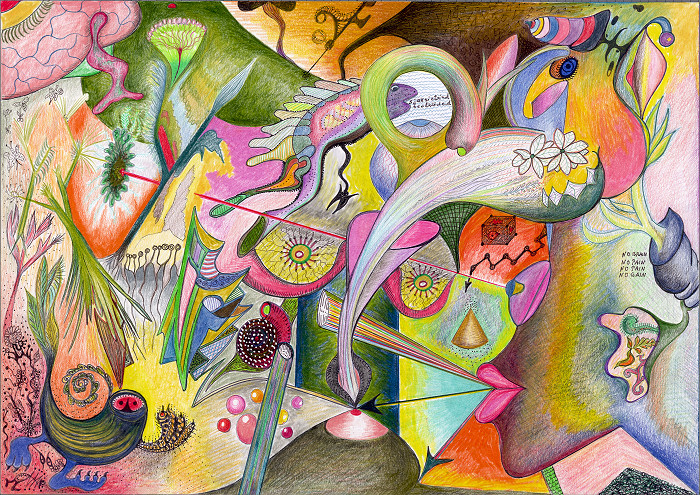
“X-Ray”
X-Ray was drawn on paper with color pencils in 1995, size about
42x30 cm. It was digitized as a high-end scan and has been reworked
in details. Print: Piezo-Print on Somerset Velvet Size: Paper: 76x112 cm, Picture: 66x94 cm Copies: 25, numbered and signed, and 5 artist's copies (I-V) Price: 700.‒ Euros Artist: Björn Dämpfling
This is a print that is based more
than 95% on a paper drawing, with an A3
drawing with color pencils (Polychromos)
being this base. That these drawings have
been made with non-fade materials is due to
the intervention of a friend, a renowned artist
who mentioned to me why in hell I couldn’t
use good artist paper and pencils and so
I did. The new material quality of my drawings
though did not become any essential
for me, I was just happy about the extended
color spectrum. This may explain to others
why seeing a drawing as an unique copy,
the equivalence of drawing and oils just in
this respect for example, never was of much
importance to me. Working with oils or pastels
it was and is the sensuality of the material
too, being a special stimulus. But drawing
happened always for me on paper the
same way I work with my computer’s monitor,
ignoring materiality. Which texture does
fantasy have? Quite often I drew on graph
paper, because I had it at hand. But those
little squares were not there for me, I ignored
them altogether and later on I took
the computer and removed them completely
especially when using such images for a hybrid
work. The size of my drawings stemmed
from the paper at hand, not the size in
which I “saw” the imagery. For this reason I don’t see in these cases my
drawing as the “original” and the digital print as a “copy”, but
instead
as a transposition for which quantity, size, turns into a new quality,
defining its own aesthetic dimension. The purely accidental or
technical size limit is taken away, and I can give the image its
“adequate” size, because this is, like others of this type,
essentially a “big”
image. This transposition became only possible through digital production
technique, because other tries from artists with traditional
photographic
means did not work well technically and they were not accepted by the art
market as well. But with high-end-scanning the results
are fully on par with the drawing, though complete identity can not be
reached because the color spectrum of the pigmented inks used for
the digital print differs inevitably a bit. Since “reproduction” is not
my goal, but instead creating printed graphics, this adds to the
autonomous
quality of these prints. The underlying drawings are in these cases just
printing plates for me, nothing else.

